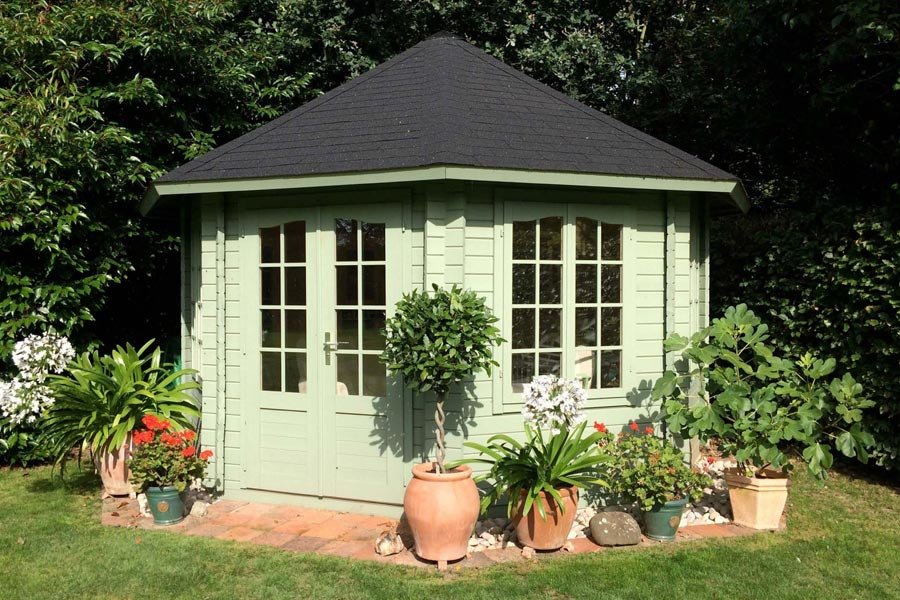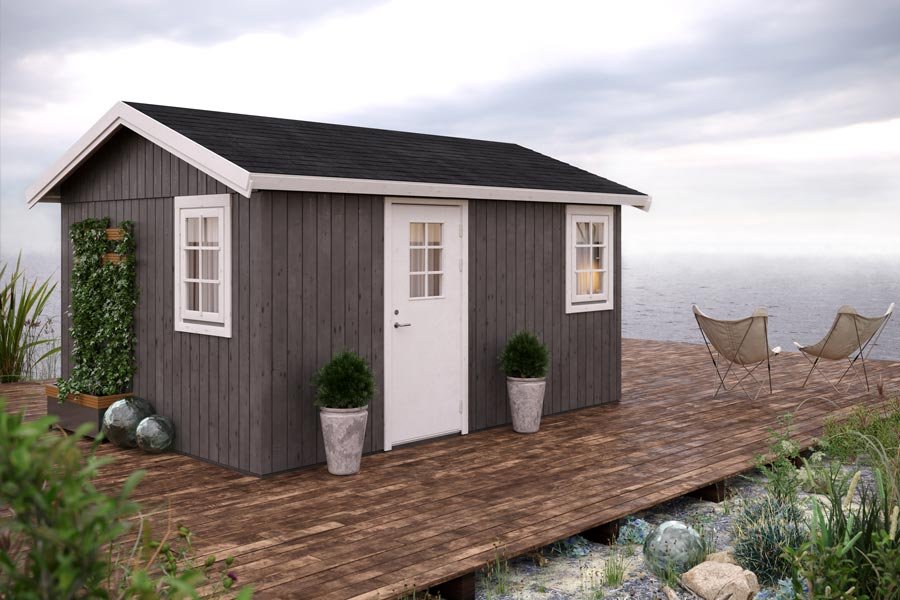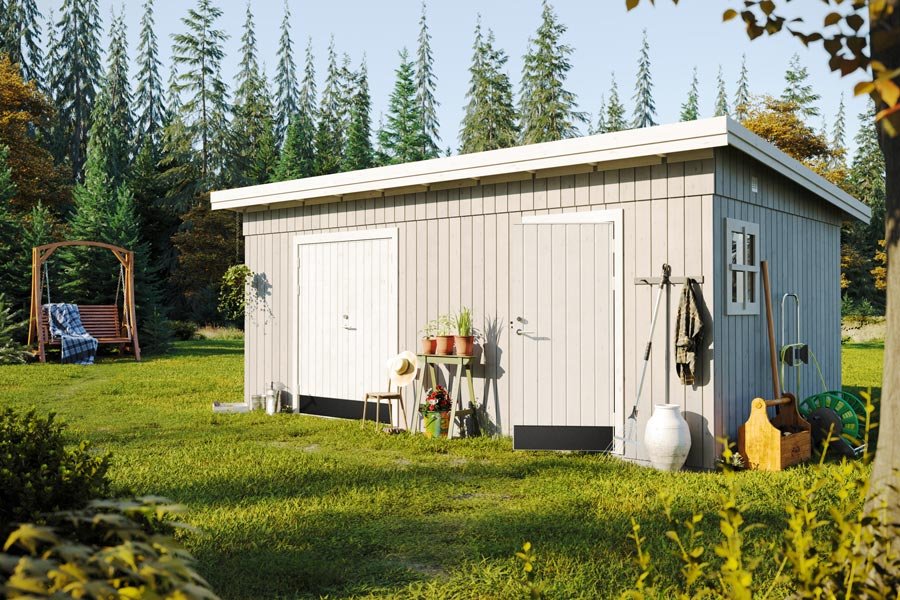
by Mark Bailey | Jan 28, 2014 | GardenLife Magazine
 Winter gales and March storms force many shed and summerhouse owners to think about insurance. From wind ripping off roof felt to sheds and timber garden rooms being flattened by fallen trees, there’s plenty that can happen to a garden building, however robust. So the question is, does home insurance cover garden buildings such as sheds, garages, summerhouses and even log cabins?
Winter gales and March storms force many shed and summerhouse owners to think about insurance. From wind ripping off roof felt to sheds and timber garden rooms being flattened by fallen trees, there’s plenty that can happen to a garden building, however robust. So the question is, does home insurance cover garden buildings such as sheds, garages, summerhouses and even log cabins?
Insuring garden buildings
The good news is that most building insurance policies cover outbuildings too – not just damage caused by falling trees either, but problems like fire or subsidence. However, storm damage to lightweight garden sheds is a grey area. Some insurers lump garden sheds in with garden fences, as being too flimsy to cover for storm damage. If you’re not sure if you’re shed our out building is cover it is always best to check before any damage occurs; a quick call to your insurer should resolve any worries.
Insuring the contents
If you have a garden building you also need to think about insurance for the contents of that shed, cabin or garden room – not just against winter weather disasters, but fire and theft. According to an article by Direct Line, the average household has over £1200 worth of garden and garage equipment, so check that your home insurance policy covers the content, and not just damage to the structure.
If you have a summerhouse with rugs, paintings and garden furniture, a garden room with a bar, pool table and games, or if have a garden gym with workout equipment, the contents may well be worth a lot more than £1200. If so, it’s even more important to check your contents insurance policy:
- Some policies cover a maximum of just £1500 worth of kit in outbuildings; others stretch to £2,000 or even £5,000.
- Some place limits on the value you can claim for a single item, so beware if you have expensive telescopes or home cinema systems in a garden building. There may also be specific cover or conditions for bikes.
We all know how boring it is to check the small print of an insurance policy, but it’s better to do so before a tree falls down or your bike disappears in the night.
Working from home
The situation with both building and contents insurance gets more complicated if you use a garden cabin to work from home. Whilst some domestic policies may include insurance on office furniture and hardware, they certainly won’t cover you if you’re running a business from home (you’re require separate business insurance for this). But as home-working and home businesses become more common, it’s getting easier to get affordable insurance cover on a garden business. Insurers such as Henshalls, John Lewis, Swinton, Business Home Insurance and others should be able to help.
Improve your garden security
Whether you’re covered for £1500 or £5000, or if you just enjoy lounging in your summerhouse or run a business from a garden office, insurers require outbuildings to be in good condition, and to be secure. They also expect a decent level of maintenance in terms of roof felt and electrical wiring. You may benefit from lower premiums and/or easier claims if you make your garden and outbuildings more secure:
 Buy a garden building with sturdy locks built in (all GardenLife buildings come with strong cylinder locks as standard) or use stout padlocks.
Buy a garden building with sturdy locks built in (all GardenLife buildings come with strong cylinder locks as standard) or use stout padlocks.- Remember to use building locks – you may not be able to claim on insurance if something is stolen as a result of the door being left open.
- Don’t leave valuable items such as bicycles, tools or computers easily visible through shed windows – curtains, blinds and lockable cabinets can all help keep valuables out of view.
- Install automatic security lights in your garden; you can now get solar powered security lights which can be fitted to garden buildings without mains electricity.
- Noisy, loose gravel on paths can deter intruders because the noise of footsteps alerts homeowners.
 Rotten door and window frames make it easier for thieves to get into a shed, even if it’s locked. So, buy a garden building with laminated door and window frames (which won’t rot), and consider double glazing rather than cheaper plexi glass (which saves money initially but isn’t as secure).
Rotten door and window frames make it easier for thieves to get into a shed, even if it’s locked. So, buy a garden building with laminated door and window frames (which won’t rot), and consider double glazing rather than cheaper plexi glass (which saves money initially but isn’t as secure).- Invest in a shed alarm, available from good DIY stores.
If you’d like more information about any of the security features on GardenLife cabins please don’t hesitate to call or email.
by Mark Bailey | Jan 16, 2014 | How to guide
Ever wanted to know how a timber summerhouse is built? Interested in one of the many GardenLife log cabins or timber buildings but not sure if you’ll be able to build it yourself? Well why not make a cup of tea or coffee, grab a biscuit and watch this video on how a timber summerhouse is built (in this case, it’s the lovely Wye clockhouse-style summerhouse). You can see how the different elements are laid out first, almost like building blocks. Watch as numbered timber sections are easily dropped in place, and how the two-man construction crew build this garden summerhouse in straight forward stages with basic DIY tools. From the floor to wall elements, windows to the roof, it’s all covered in this helpful video. Any questions? Just get in touch for more information.

by Mark Bailey | Jan 6, 2014 | GardenLife Magazine
 There’s been much in the news in recent months about threats to trees and forests – from ‘ash dieback’ to ‘sudden oak death’, and of course deforestation continues in many parts of the world. So when you buy timber products, it’s important to know that they come from sustainable sources. Purchasing wood from well-managed forests means you can buy timber with a clear conscience, confident you’re not damaging forests and woodlands for future generations.
There’s been much in the news in recent months about threats to trees and forests – from ‘ash dieback’ to ‘sudden oak death’, and of course deforestation continues in many parts of the world. So when you buy timber products, it’s important to know that they come from sustainable sources. Purchasing wood from well-managed forests means you can buy timber with a clear conscience, confident you’re not damaging forests and woodlands for future generations.
The best way to enjoy this peace of mind is to buy products from an FSC-certified business. FSC is the Forest Stewardship Council, and it’s a worldwide organisation promoting ‘environmentally appropriate’ management of the world’s forests. Businesses with FSC certification (which is voluntary) comply with high environmental and social standards.
 As part of the Lemeks Group of companies, GardenLife belongs to an FSC-certified enterprise, and we sell a number of products made from FSC-certified timber. You can see the FSC logo (the ‘tick tree’) on many of the cabins and play sets on our website. Purchase a product marked with this icon means that you are buying an FSC-certified garden building.
As part of the Lemeks Group of companies, GardenLife belongs to an FSC-certified enterprise, and we sell a number of products made from FSC-certified timber. You can see the FSC logo (the ‘tick tree’) on many of the cabins and play sets on our website. Purchase a product marked with this icon means that you are buying an FSC-certified garden building.
What do we mean by ‘sustainable timber’?
Organisations like the FSC are concerned about the environmental management of forests, but they also look into social and economic aspects too. So – and please excuse us, but things may get a bit jargon-heavy for a while – to this end, they also promote ‘socially beneficial and economically viable’ management of the world’s forests. For example, among the ten FSC principles which forest owners/managers have to follow are: identifying and upholding indigenous people’ rights of ownership and use of land and resources; and maintaining forest workers’ and local communities’ social and economic well-being.
If you want to know more about the FSC and its principles, go to its website at www.fsc-uk.org.
Well-managed forests are not just about timber
You’ll find the FSC logo around the GardenLife website. But where else should you look for it? The obvious place is on other timber products, including decking, flooring and furniture.
And then there are products that aren’t quite so obvious, until you think about it: For example:
- items made out of bamboo, rattan, straw and cork
- charcoal
- paper, cardboard and other packaging
- tissues and napkins
They all come from trees, of course, and so it’s just as important that they’re sourced from well-managed forests. And a couple of years back the world’s first FSC certified woodwind instrument was put on sale – made out of African blackwood (one of the world’s most valuable timbers) sourced from certified forests in Tanzania.
Other forest-sourced products also require sustainable management if we are not to deprive future generations of them. So, among the other products certified by the FSC are: medicinal plants and pharmaceutical raw materials; rubber, latex, and other products manufactured from natural gums; and food, including nuts, tea, mushrooms, honey and game.
The Nordic connection
 But back to timber. Another factor that lets you buy GardenLife cabins with a clear environmental conscience is that they’re made from sustainable Nordic timber.
But back to timber. Another factor that lets you buy GardenLife cabins with a clear environmental conscience is that they’re made from sustainable Nordic timber.
Forestry is a huge business in the Nordic and Baltic countries – especially Estonia (home of the Lemeks Group), Finland and Sweden. Since the forests are a major source of revenue and employment, and a strong part of these countries’ culture and history, they enjoy significant legal protection. There are strict rules about how much timber can be harvested, and how much must be replanted.
You can be sure that by buying cabins made from Baltic timber, you’re buying wood carefully sourced from sustainable forests. So when you are browsing the GardenLife website look out for the FSC logo – you can buy an FSC-certified garden building, summerhouse or children’s playset safe in the knowledge that the timber came from sustainably managed forests.

 Winter gales and March storms force many shed and summerhouse owners to think about insurance. From wind ripping off roof felt to sheds and timber garden rooms being flattened by fallen trees, there’s plenty that can happen to a garden building, however robust. So the question is, does home insurance cover garden buildings such as sheds, garages, summerhouses and even log cabins?
Winter gales and March storms force many shed and summerhouse owners to think about insurance. From wind ripping off roof felt to sheds and timber garden rooms being flattened by fallen trees, there’s plenty that can happen to a garden building, however robust. So the question is, does home insurance cover garden buildings such as sheds, garages, summerhouses and even log cabins? Buy a garden building with sturdy locks built in (all GardenLife buildings come with strong cylinder locks as standard) or use stout padlocks.
Buy a garden building with sturdy locks built in (all GardenLife buildings come with strong cylinder locks as standard) or use stout padlocks. Rotten door and window frames make it easier for thieves to get into a shed, even if it’s locked. So, buy a garden building with laminated door and window frames (which won’t rot), and consider double glazing rather than cheaper plexi glass (which saves money initially but isn’t as secure).
Rotten door and window frames make it easier for thieves to get into a shed, even if it’s locked. So, buy a garden building with laminated door and window frames (which won’t rot), and consider double glazing rather than cheaper plexi glass (which saves money initially but isn’t as secure).

















